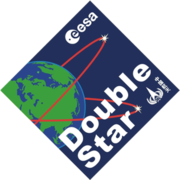Double Star mission
| Names | Tan Ce (Explorer) |
|---|---|
| Mission type | Earth observation |
| Operator | CNSA · ESA |
| COSPAR ID | 2003-061A (TC-1) 2004-029A (TC-2) |
| Website | ESA website (archive) |
| Mission duration | 3 years, 9 months, 15 days (TC-1) 12 years, 6 months and 19 days (TC-2) |
| Start of mission | |
| Launch date | 29 December 2003, 19:06 UTC (TC-1) 25 July 2004, 07:05 UTC (TC-2) |
| Rocket | Long March 2C |
| Launch site | Xichang Satellite Launch Center |
| End of mission | |
| Disposal | Deorbited |
| Decay date | 14 October 2007 (TC-1) |
 ESA quadrilateral mission insignia for the Double Star mission. |
|
Double Star is a joint satellite based space mission by the China National Space Administration (CNSA) and the European Space Agency (ESA). It is the first space mission launched by China to investigate Earth's magnetosphere. It consists of two satellites: an Equatorial satellite (TC-1) and Polar satellite (TC-2). Double Star follows in the footsteps of ESA's Cluster mission by studying the effects of the Sun on the Earth's environment. After a nominal mission of one year (from the launch of TC-2 in July 2004), the Double Star mission was extended twice by both agencies till the end of September 2007.
The Double Star mission uses two satellites in Earth orbit - each designed, developed, launched, and operated by the China National Space Administration. ESA has agreed to contribute 8 million Euros to the Double Star programme. This funding will be used for refurbishment and pre-integration of the European instruments, acquisition of data for four hours per day and co-ordination of scientific operations. This schedule enabled Double Star to operate simultaneously with ESA's Cluster mission.
The first equatorial spacecraft (Tan Ce 1, Chinese for 'Explorer 1', also known as TC-1) was launched by a Long March 2C launch vehicle on December 29, 2003 at 19:06 UT. Its purpose was to investigate Earth's huge 'magnetotail', the region where particles are accelerated towards the planet's magnetic poles by a process known as 'reconnection'.
The second polar spacecraft (TC-2) was launched July 25, 2004 at 07:05 UT, also by Long March 2C. It will concentrate on physical processes taking place over the magnetic poles and the development of aurorae.
The mission formally ended on October 14, 2007 when the TC-1 spacecraft re-entered the Earth's atmosphere after being decommissioned (an unavoidable consequence of its equatorial orbit). The TC-2 spacecraft and payload continues to operate though financial support from ESA/STFC has been discontinued.
...
Wikipedia
